Ducks with blue bills are a unique and fascinating species of birds that capture the attention of many birdwatchers and nature enthusiasts. With their distinct appearance and fascinating behavior, blue-billed ducks have become a symbol of beauty and grace in the avian world.
These birds are found in various parts of the world and are known for their vibrant plumage, striking blue bills, and playful personalities.
Whether you’re a seasoned birder or just starting to develop an interest in birds, ducks with blue bills are sure to captivate and delight you.
American Wigeon
American Wigeon

The American wigeon is a species of duck that can be seen in wetland areas across the United States and Canada.
- A popular game bird hunted extensively in the winter months.
- Primarily feeds on aquatic vegetation, making it common in shallow marshes and ponds
- Hardy and adaptable species with a large population
The American wigeon (Anas Americana) is a dabbling duck native to North America. It is easily recognizable by its unique head shape, which features a distinctive green, white and blue-gray feather pattern. This species is a popular game bird hunted extensively during the winter months in North America.
The American wigeon primarily feeds on aquatic vegetation, which makes it a common sight in shallow marshes and sewage ponds.
During the breeding season, the male displays an attractive courtship display involving head pumping, wing flapping, and calls. The American wigeon is a hardy and adaptable species with a large population and is not considered to be threatened.
Andean Duck
Andean Duck
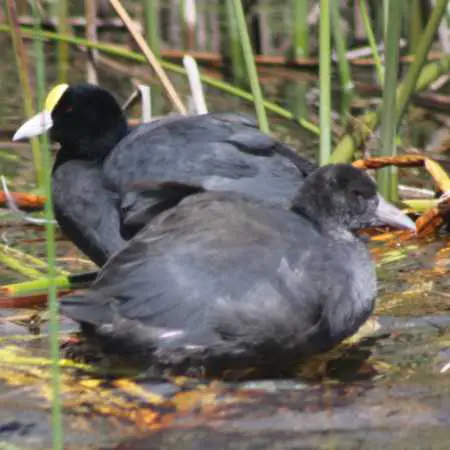
The Andean duck is a prolific water bird native to the tropical lowlands of South America.
- Andean ducks are waterfowl native to the Andean Mountains and their surrounding regions.
- The Andean duck feeds mainly on aquatic plants and insects.
- Some flocks migrate southwards to Argentina in the winter, while others remain in their range year-round.
The Andean duck (Oxyura ferruginea) is a bird native to the Andean Mountains and part of the stiff-tailed ducks. It has a distinctively peaked head, a short thick neck and a rich chestnut body.
During summer, the male ducks sport brightly colored blue bills, which shift to dull gray-brown above and paler below, with dull gray bills in winter.
Andean ducks feed mainly on aquatic plants and insects. These birds migrate southwards to Argentina when the weather turns colder but may remain in their breeding grounds due to favorable conditions.
Baer’s Pochard
Baer’s Pochard

The Baer’s pochard is a species of diving duck that breeds in inland wetlands of eastern Asia.
- Baer’s pochard has a distinctive black head and neck with green gloss.
- The species breeds in emergent vegetation in shallow water or on islands. Males take sentry duty while females incubate the eggs.
- It inhabits slow-flowing lakes and freshwater swamps, forming huge flocks during winter when it migrates to southern China and other parts of East Asia.
Baer’s pochard (Aythya baeri) is a diving duck found in Eastern Asia. It has a distinctive black head and neck with green gloss, white flanks and a rounded head, which differentiates it from the similar ferruginous duck.
Baer’s pochard breeds in emergent vegetation in shallow water or on islands, and the males take on sentry duty while females incubate. It is a shy species, inhabiting slow-flowing lakes and swamps, forming flocks in winter.
It breeds in North and Central China and migrates to southern China, Japan, and India in winter.
The species is critically endangered due to habitat loss and hunting, with an estimated population of fewer than 1,000 individuals.
Blue-billed Duck
Blue-billed Duck
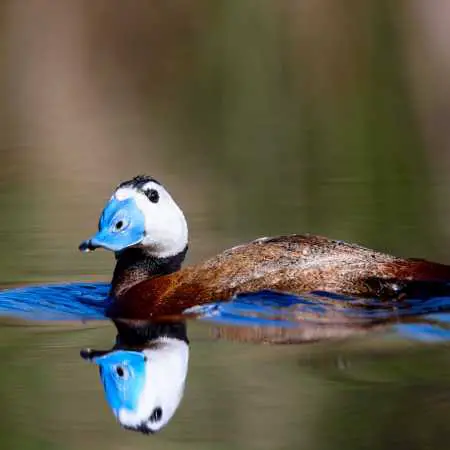
The blue-billed duck is a rare species found mainly in New South Wales, Australia and New Guinea.
- The duck is an endemic small Australian duck species found in temperate regions.
- It grows to 40 cm and is omnivorous, with a preference for small aquatic invertebrates.
- The blue-billed duck inhabits natural and artificial wetlands.
The blue-billed duck (Oxyura australis) is an endemic small Australian duck species found in temperate regions. It grows to 40 cm and is omnivorous, with a preference for small aquatic invertebrates.
Males have a slate-blue bill that turns bright blue during the breeding season and has deep chestnut plumage. Females black plumage with brown tips year-round.
Most blue-billed ducks stay in water and along the shore because they have difficulty walking on land.
The duck is almost entirely aquatic and difficult to observe due to its cryptic nature during the breeding season. The male has a complex mating ritual, and the female builds the nest.
The blue-billed duck inhabits natural and artificial wetlands and is considered “Least Concern” by BirdLife International. Threats to the species include the drainage of permanent wetlands, degradation due to introduced fish, cattle grazing, salinization and lowering of groundwater.
Blue-billed Teal
Blue-billed Teal
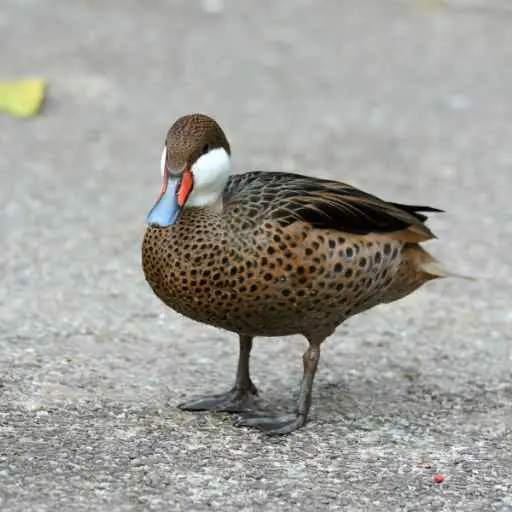
The blue-billed teal can be found in sub-Saharan Africa, easily identified by its unique bright blue bill.
- The blue-billed duck is a species of dabbling duck native to eastern and southern Africa.
- They are found in freshwater habitats such as swamps, marshes, and lakes.
- The primary diet for the blue-billed duck consists of grass seeds, but they are omnivorous and will consume other items.
The blue-billed teal (Spatula hottentota) is a dabbling duck native to eastern and southern Africa, from Sudan and Ethiopia to South Africa and Namibia.
Males have a dark brown crown, paler face and iridescent green speculum on the secondaries. Females have browner crowns and less distinct markings. Juveniles resemble adult females but are duller.
The blue-billed teal prefers habitats with abundant floating-leaf plants and is found in shallow fresh-water swamps, marshes, and small lakes. It feeds in well-vegetated areas by dabbling and is omnivorous, primarily consuming grass seeds and eating aquatic invertebrates.
Blue-billed teals are sedentary in West Africa and Madagascar but partly migratory elsewhere.
Chiloé Wigeon
Chiloé Wigeon
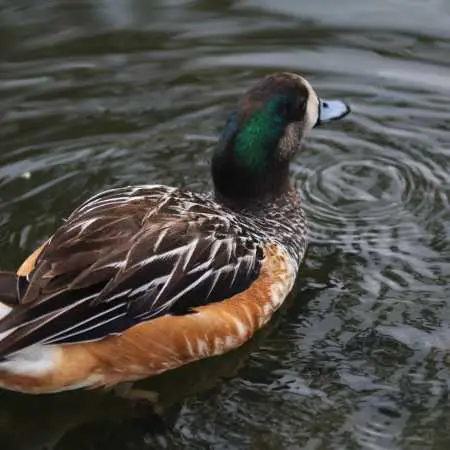
The Chiloé Wigeon is a beautiful dabbling duck that can be found in southern South America.
- This duck is an omnivore and feeds on both plants and animals.
- The Chiloé Wigeon is a migratory bird that travels to southeastern Brazil for the winter.
- This duck breeds in the springtime and the females typically lay 8-10 eggs.
The Chiloé Wigeon (Mareca sibilatrix), also known as the southern wigeon, is a dabbling duck found in southern South America, including the Chiloé Archipelago.
It has a body length of 46-56 cm and a wingspan of 75-86 cm. It has a blue-green head and black and white barred breasts. Sexual dimorphism is subtle, with males slightly larger and brighter in plumage.
It is an omnivore found in freshwater habitats and migrates to southeastern Brazil for the winter.
Breeding occurs in the southern parts of South America and the Falkland Islands in the spring, with the female laying 8-10 eggs. The father helps raise the ducklings but eventually leaves after they molt.
Common Pochard
Common Pochard
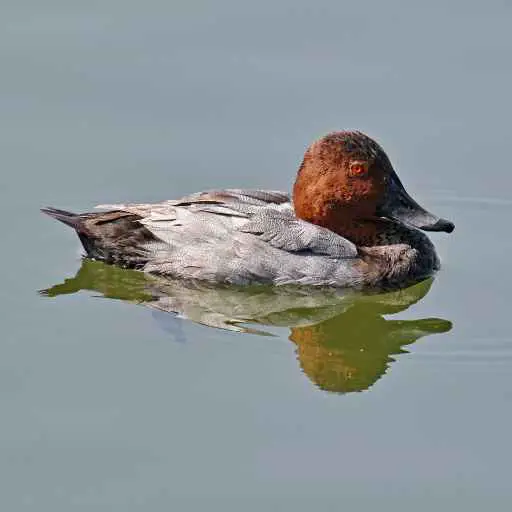
The common pochard is a medium-sized diving duck with a distinctive triangular head shape.
- The common pochard is a unique and beautiful duck that can be found in Europe.
- These ducks are very friendly and often form flocks.
- Pochards feed mainly by diving or dabbling for aquatic plants, mollusks, insects, and small fish.
The common pochard (Aythya ferina) is a medium-sized diving duck with a distinctive triangular head shape. Males have a red head, black breasts and grey back, while females have a brown head and body with a narrower grey bill-band.
They breed in temperate and northern Europe and migrate to the south and west of Europe in winter. In the British Isles, they breed in eastern England and Scotland and overwinter in large numbers.
Common pochards are gregarious birds, forming large flocks in winter, and feed mainly by diving or dabbling for aquatic plants, mollusks, insects and small fish, often feeding at night. While occasionally they stay underwater in deeper waters, they prefer shallow waters most of the time.
Eurasian Wigeon
Eurasian Wigeon

The Eurasian wigeon is a common and widespread duck species in the Palearctic range.
- Breeds in the northernmost areas of Europe and the Palearctic
- Migrates to southern Asia and Africa
- Gregarious bird that nests on the ground near water
The Eurasian wigeon, also known as the European wigeon, is a dabbling duck species in the genus Mareca. It is widespread within its Palearctic range, breeding in the northernmost areas of Europe and the Palearctic and migrating to southern Asia and Africa.
The male in breeding plumage has a pink breast, chestnut head, and a white patch on the upper wings, while the female is light brown with a paler head.
The Eurasian wigeon is a bird of open wetlands, feeding by dabbling or grazing and nesting on the ground near water and under cover. It is highly gregarious, forming large flocks, and is a noisy species that can hybridize with American wigeons in the US.
Greater Scaup
Greater Scaup
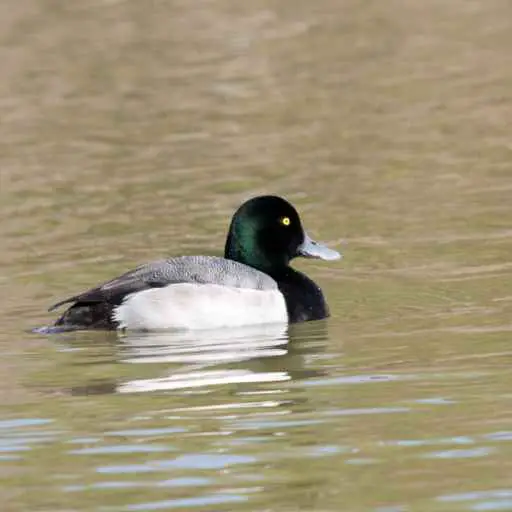
The greater scaup is a beautiful mid-sized duck that is native to the Arctic Circle.
- The drakes have a blue bill, yellow eyes, and a black head with a green gloss.
- The females are mostly brown with a dull blue bill.
- Feeds on aquatic mollusks, plants, and insects and form large groups called “rafts”.
This duck is a mid-sized diving duck that breeds in the Arctic Circle and migrates to the coasts of North America, Europe, and Japan during winter.
The drakes have a blue bill, yellow eyes, and a black head with a green gloss, while the females are mostly brown with a dull blue bill. The birds nest near water, breed at age two and form monogamous pairs.
It feeds on aquatic mollusks, plants, and insects and forms large groups called “rafts.
Populations have declined since the 1980s but are still listed as a species of least concern. The greater scaup’s main threats are human development and predation by owls, skunks, raccoons, foxes, coyotes, and humans.
Harlequin Duck
Harlequin Duck
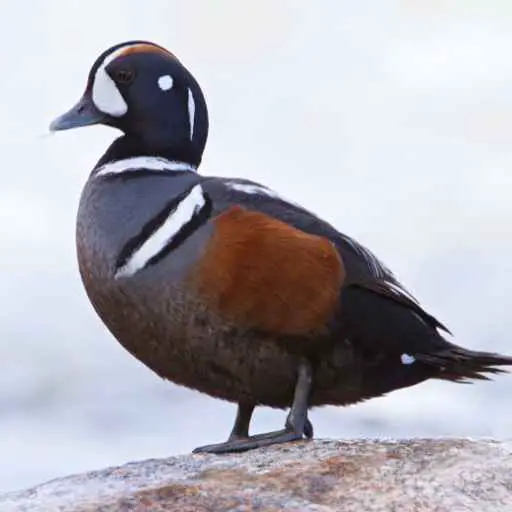
The harlequin duck is a small sea duck with distinctive plumage patterns.
- Males have colorful heads and necks, blue bodies, black tails and metallic blue speculums, while females are brownish-grey with three white patches on the head.
- Breeding habitats include fast-moving streams in North America, Greenland, Iceland and eastern Russia, where they feed on mollusks, crustaceans and insects.
- They form monogamous pair bonds for mating purposes.
The harlequin duck (Histrionicus histrionicus) is a small sea duck with distinctive plumage patterns.
Breeding males have a colorful head and neck with chestnut patches, a black-bordered white collar, a blue body with chestnut sides and a black-bordered white bar, a black tail, a metallic blue speculum.
Female adults have brownish-grey plumage with three white patches on the head.
These ducks feed on mollusks, crustaceans, and insects.
Harlequins form monogamous pair bonds, and both partners show mate choice preference. The eastern North American population is declining and considered endangered.
Harlequin ducks breed near fast-moving streams in north-western and north-eastern North America, Greenland, Iceland and eastern Russia.
Lake Duck
Lake Duck
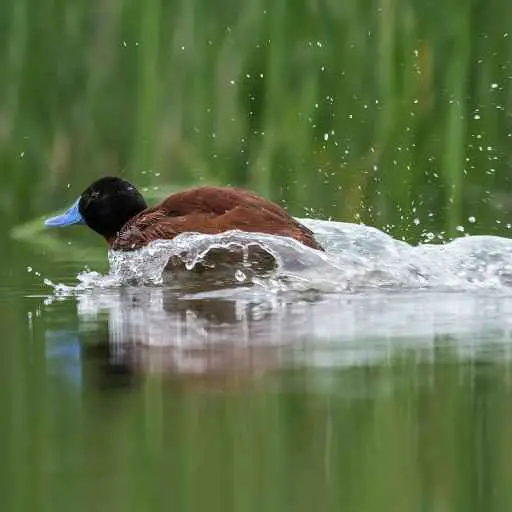
The lake duck (Oxyura vittata) is a small diving duck that is mainly found in freshwater, typically inhabiting open lakes and large rivers.
- It is a small stiff-tailed duck native to South America.
- It is an omnivorous species that feeds on seeds, plants and small invertebrates.
- It is partially migratory, traveling short distances searching for food and suitable habitats.
This duck is a small South American stiff-tailed duck. Males are smaller and have flatter heads compared to a similar species, the Andean duck. It feeds on small invertebrates, seeds, and plant remains.
Breeding occurs from October to January in Argentina, with males producing popping and rustling noises for display. It is a partially migratory species found in freshwater habitats with vegetation, occurring in several South American countries and introduced to Antarctica and the Falklands.
Its population size is stable, with 6,700 to 67,000 individuals, and there are no major threats to the species.
Lesser Scaup
Lesser Scaup

The lesser scaup is a small North American diving duck.
- Breeds in inland lakes in the tundra
- Feeds on aquatic plants and supplements diet with mollusks, clams and invertebrates
- Nest consists of a shallow depression scraped on the ground lined with down feathers among thick vegetation near water bodies
The lesser scaup is a small diving duck found in North America that migrates south for the winter. The male has a black head and breast, a white back and underparts, and a blue bill. The female is dark brown with a white band on the bill and a lighter ear region.
They breed in tundra lakes and marshes in Alaska, Canada, and Montana and winter in lakes, rivers, and coastal bays between the US-Canada border and northern Colombia.
They forage mainly by diving and eating mollusks and other aquatic plants and animals.
The nest is a shallow depression near water lined with plants and feathers. They lay about 9-11 eggs, and incubation is done by the female only.
Maccoa Duck
Maccoa Duck
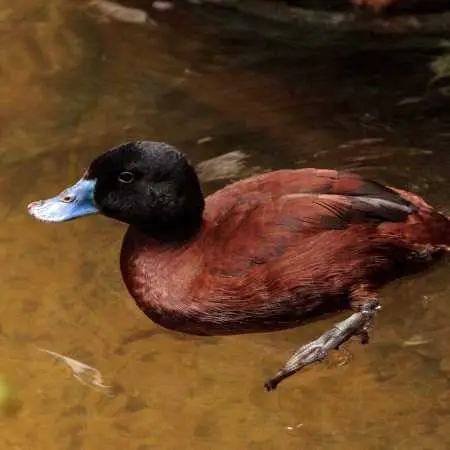
The Maccoa duck is a stiff-tailed diving duck native to Eastern and Southern Africa.
- Breeds near open freshwater with adjacent emerging vegetation
- Thrives on a varied diet consisting of aquatic invertebrates and plants
- Occupies fresh and brackish inland waters
The Maccoa duck is a diving duck found in Eastern and Southern Africa. It is specialized for diving and has a body structure that makes walking awkward when walking on land.
The breeding male Maccoa has a cobalt blue bill, a black head and throat, chestnut-colored breast and back, and a dark brown rump.
The female Maccoa is less colorful, with a light brown face, a dark crown, and pale brown breast.
The ducks occupy inland waters during non-breeding seasons and prefer habitats with open freshwater and emerging vegetation during breeding. The main populations are spread apart due to a lack of desirable wetland habitats.
Maccoas are omnivores and feed on aquatic invertebrates, seeds, and plants.
Male Maccoa ducks are polygynous. The species mates and lays eggs between January and May. The incubation period lasts for 25 to 27 days.
The Maccoa ducks have adapted well to water management techniques and human infrastructure, as many flocks have been living behind dams.
Masked Duck
Masked Duck

The masked duck is a small, stiff-tailed duck found in tropical areas.
- Not rare, but very secretive
- Feeds mainly on seeds, roots, stems and leaves of aquatic plants
- Breeds in freshwater bodies surrounded by marsh vegetation & heavy tree cover or mangrove swamps
The masked duck (Nomonyx dominicus) is a small duck species found in the tropical Americas, from Mexico to South America and the Caribbean.
It has a rust-colored body with a black face for breeding adult males and a barred brownish-gray body for adult females, winter males and juveniles.
It feeds on seeds, roots, stems, leaves, insects, and crustaceans, diving for food.
The masked duck breeds in freshwater bodies with marsh vegetation and heavy tree cover and is usually secretive. The species is not considered threatened by the IUCN.
Northern Pintail
Northern Pintail

The northern pintail is a species of duck that breeds in the Northern areas of Europe, the Palearctic and North America.
- Breeding males have a chocolate-brown head and white breast
- Migrates to warmer regions south of its range during the winter season
- Breeds in open unwooded wetlands such as wet grassland or tundra
The northern pintail (Anas acuta) is a species of duck with a wide geographic distribution, breeding in northern Europe, the Palearctic, and North America. It is migratory, spending the winter in areas south of its breeding range, reaching almost to the equator.
The male has a chocolate-brown head and white breast, while the female is mottled in light brown. Juvenile birds resemble females.
The pintail is gregarious and forms large mixed flocks with other ducks outside the breeding season.
Both sexes reach sexual maturity at one year of age and breed between April and June.
The pintail feeds by dabbling and upending in shallow water for plant food, mainly in the evening or at night. Winter diet is mainly plant material, supplemented by mollusks and small crustaceans.
Pacific Black Duck
Pacific Black Duck

The Pacific black duck is a sociable dabbling duck found in many islands of the southwestern Pacific.
- Males tend to be larger than females
- Feeds on seeds from aquatic plants supplemented by small crustaceans, mollusks and insects
- Similar nesting habits with mallards
The Pacific black duck (Anas superciliosa) is a dabbling duck found in various regions such as Indonesia, New Guinea, Australia, New Zealand, and islands in the southwestern Pacific.
It is similar to the mallard, with a dark body, paler head, crown, and facial stripes. The female produces a sequence of rapid quacking, which decreases in volume.
The Pacific black duck is primarily vegetarian and obtains food by dabbling or seeking food on land in damp grassy areas. It’s a sociable bird that feeds mainly on seeds of aquatic plants and consumes small crustaceans, mollusks, and insects.
The nest is usually placed in a tree hole or an old corvid nest, and the female incubates the 8-10 pale cream eggs. The precocial ducklings can fly at around 58 days of age.
Philippine Duck
Philippine Duck
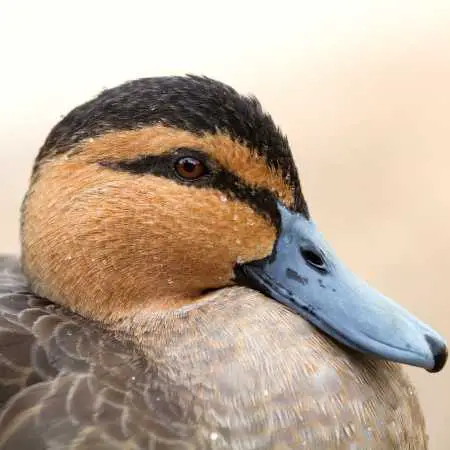
The Philippine duck is a large dabbling duck endemic to the Philippines.
- Both sexes have a similar appearance
- Females are slightly smaller than the males
- Lives in shallow freshwater marshland
The Philippine duck is a large dabbling duck that is endemic to the Philippines.
It has a distinctive appearance with a black crown, nape, eye stripe, and a cinnamon head and neck.
Its preferred habitat is shallow freshwater marshland. It frequents all wetlands and eats shrimp, fish, insects, and vegetation.
It is mainly found on the islands of Luzon and Mindanao but has also been sighted in Okinawa and Taiwan as a long-distance vagrant.
Puna Teal
Puna Teal
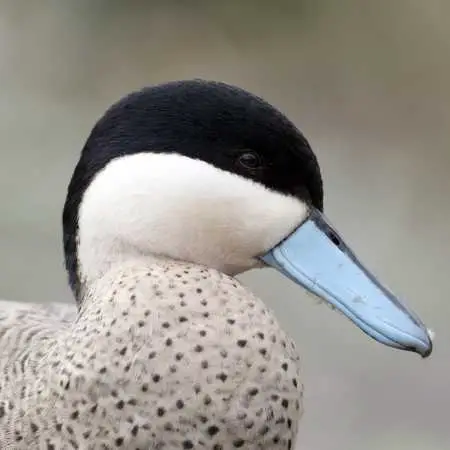
The Puna teal (Spatula puna) is a species of dabbling duck found in the Andes region.
- Lives in small groups
- Breeds between April and June
- Mainly feeds on aquatic vegetation
The Puna teal (Spatula puna) is a species of dabbling duck native to the Andes region of Peru, western Bolivia, northern Chile and extreme northwestern Argentina.
It is easily identified by its striking black caps, creamy white lower faces and necks, gray upper tail coverts, and thin stripes of dark brown feathers on the rear flanks. It has a bluish bill and feature a black line down the center.
The Puna teal thrives in various habitats, including salt-water marshes and mountain streams. It lives alone or in mixed flocks during the non-breeding season. It migrates over long distances to seek favorable environmental conditions.
Its diet consists of aquatic plants and insects, and may also feed on grains further away from water.
Females lay eggs in April-June.
Redhead
Redhead

The redhead is a medium-sized diving duck.
- Found all over North America
- Migrates south to Mexico or Central America during the winter months
- Feeds on aquatic vegetation and invertebrates
The Redhead is a beautiful medium-sized diving duck recognized for its striking copper and black plumage, particularly in males. With their copper heads and necks, black breasts and grey backs, they are unmistakable during the breeding season. Their bluish bills have black tips. During the non-breeding season, males will have brown heads instead of copper ones.
Females have yellow-brown heads and necks, a slate-colored bill with a dark tip divided by blue rings, and white bellies that stand out against their dark grayish-brown bodies.
Redhead ducks are found in wetland areas all over North America, migrating south to Mexico and Central America for milder weather during winter.
Many ducks feed on aquatic vegetation and invertebrates.
They typically nest in shallow depressions near the water’s edge and in tree cavities further away from water sources.
Ringed Teal
Ringed Teal
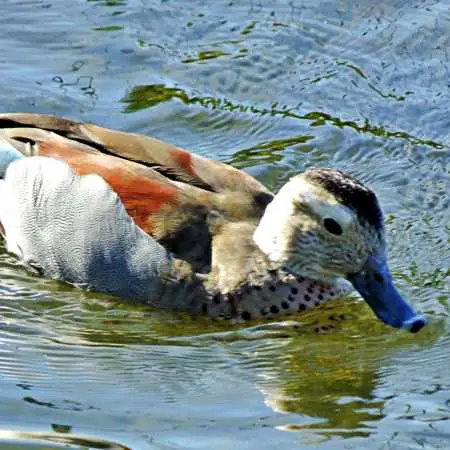
The ringed teal is a small duck species found in the South American forest.
- Forms strong pair bonds through courting
- Nests are usually made in tree cavities
- Feeds primarily on aquatic plants, invertebrates and seeds
Ringed teals form strong pair bonds, lasting a single breeding season or lifetime. The pair bonds are solidified through courting, which involves preening, wing flashing, and vocalization.
The ringed teal is a small duck species found in South American forests. It is notable for its distinctive appearance, with the male having an intense chestnut back, salmon-colored breast, and black band on its head, and the female having an olive-brownish back with white blotches.
Nests are usually made in tree cavities; the female incubates the eggs while the male defends the nest.
The ringed teal is a predominantly aquatic species that feeds on aquatic plants, invertebrates, and seeds. It is classified as a dabbler, meaning it feeds near the surface of the water but not by diving.
Their habitats include tropical forests, marshy clearings, and small streams.
Ringed teals can live up to 15 years in captivity, but their average lifespan in the wild is unknown.
Ruddy Duck
Ruddy Duck

The ruddy duck (Oxyura jamaicensis) is a small, compact duck found in North America.
- Breeds in marshy lakes and ponds
- Migrates during winter to coastal bays, unfrozen lakes or ponds
- Considered an invasive species in many parts of Europe
The ruddy duck is a small duck native to North America characterized by its short, thick neck and long, stiff tail.
Male ruddy ducks have black caps and white cheeks, while females and first-year males are brownish with pale cheek patches.
Ruddy ducks breed in marshy habitats near water and feed on seeds, roots, and insects.
They were introduced to the UK in 1948 and became established in Europe. However, their aggressive courtship ritual and willingness to interbreed with the endangered native white-headed duck led to a controversial culling scheme in the UK and other European countries.
The British population has declined from a peak of 5,500 in 2000 to around 20-100 in 2014 due to the cull.
Silver Teal
Silver Teal
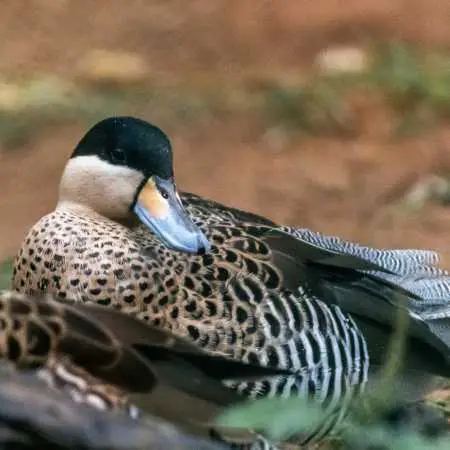
The silver teal is a dabbling duck that breeds in South America.
- Forms life-long bonds
- Docile ducks; very protective of eggs, young and mates
- Feeds primarily on aquatic plants
The silver teal, also known as the versicolor teal, is a species of duck that breeds in South America. It prefers reed beds for nesting between April and June, and both parents care for the eggs and ducklings.
The silver teal feeds on vegetable matter and lives in small groups in freshwater. Its range includes several countries in South America and nearby islands, with some birds migrating to southern Brazil in the winter.
The species is generally docile but may become protective of their eggs, young, and females.
Southern Pochard
Southern Pochard
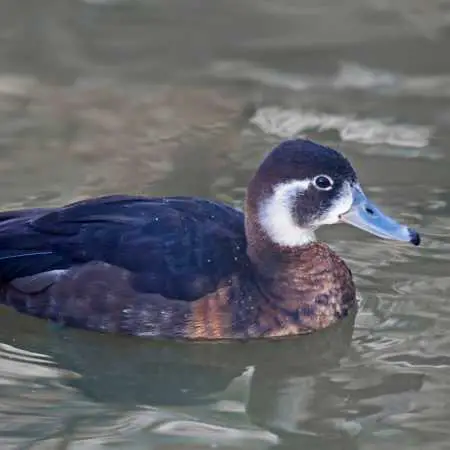
The southern pochard (Netta erythrophthalma) is a duck found in South America and Africa.
- Forms large groups of up to 5,000 individuals
- Lays between 6-15 eggs
- Has a diet that consists mainly of aquatic plants
The Southern Pochard (Netta erythrophthalma) is a duck found in both South America and Africa. It is a sociable bird, forming large groups of up to 5,000 individuals when congregating in the same area.
In South America, it inhabits shallow freshwater bodies from lowlands up to 3,700 meters in altitude, while in Africa, its range is much greater, and they are mostly found on water bodies with or without emergent vegetation.
When breeding, the southern pochard prefers to make its nest out of leaves on the banks of rivers surrounded by plenty of vegetation.
The female will lay between 6-15 eggs which she will incubate for 20-28 days before leading her chicks immediately to water after hatching.
The southern pochard’s diet consists mainly of aquatic plants, but it also eats larvae pupae and other aquatic animals and plant material when diving for food.
Common pochards are also quite adept swimmers and hunters, with their long necks being able to easily dive into the water to catch fish and other prey species.
Tufted Duck
Tufted Duck
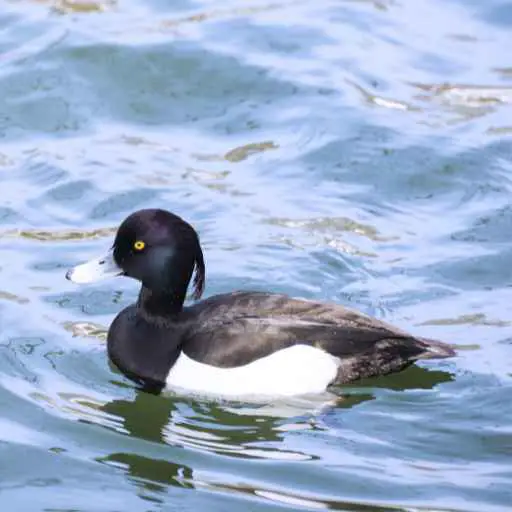
The tufted duck (Aythya fuligula) is a small diving duck found in northern Eurasia, numbering close to one million birds.
- Breeds throughout temperate and northern Eurasia
- Preferred breeding habitat includes marshes or ponds near plenty of vegetation for concealing their nesting sites.
- Feeds mainly by diving underwater for mollusks, insects or plants
This duck is a small diving duck found in northern Eurasia, with a black body with white flanks, a blue-grey bill and gold-yellow eyes.
It breeds throughout temperate and northern Eurasia and winters on both coasts of the US and Canada, with some individuals reaching as far south as Melbourne, Australia.
It dives underwater for mollusks, aquatic insects or plants and upends from the surface to search for food. It is often found with other diving ducks.
This duck has strong legs and webbed feet, enabling it to travel long distances during its migration periods.
During mating season, the adult male duck becomes more active and display elaborate courtship behaviors to attract females.
Breeding season occurs between April and May, and young ducks fledge within four weeks but remain dependent on their parents until autumn migration begins.
White-headed Duck
White-headed Duck
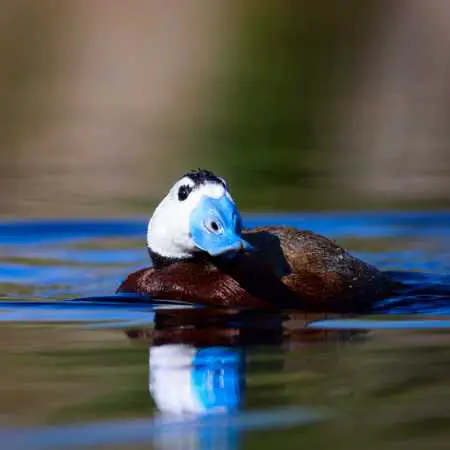
The white-headed duck (Oxyura leucocephala) is a small diving duck native to Spain, North Africa, Western Asia and Central Asia.
- Classified as ‘endangered’ by the IUCN
- Feeds on aquatic vegetation, mollusks and crustaceans
- Builds nest near the water’s edge
The white-headed duck (Oxyura leucocephala) is a small diving duck native to Spain, North Africa, Western Asia, and Central Asia.
Key Takeaways on Blue-Billed Ducks
- Our list of blue-billed ducks include 25 different species of this beautiful waterfowl.
- These ducks include many diving and dabbling ducks.
- These ducks are found throughout the world, mostly in the northern hemisphere.

